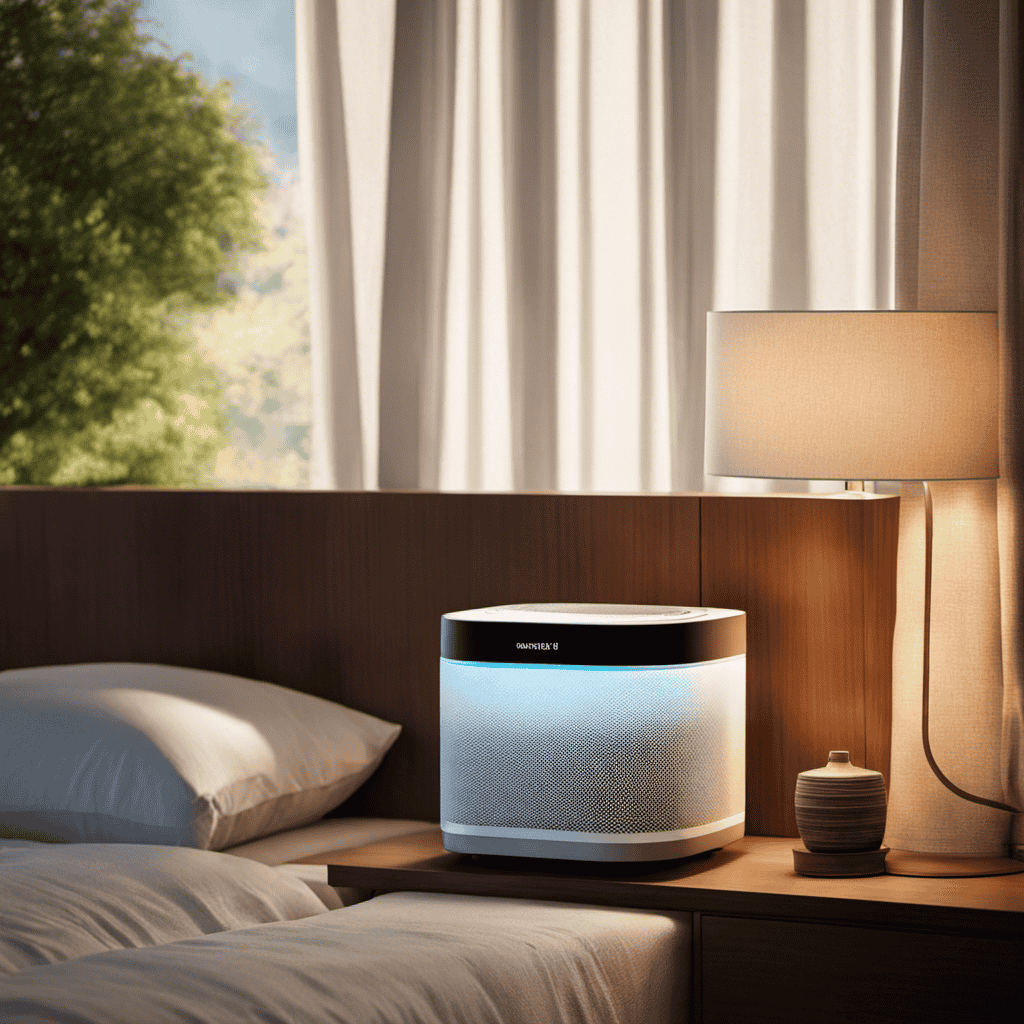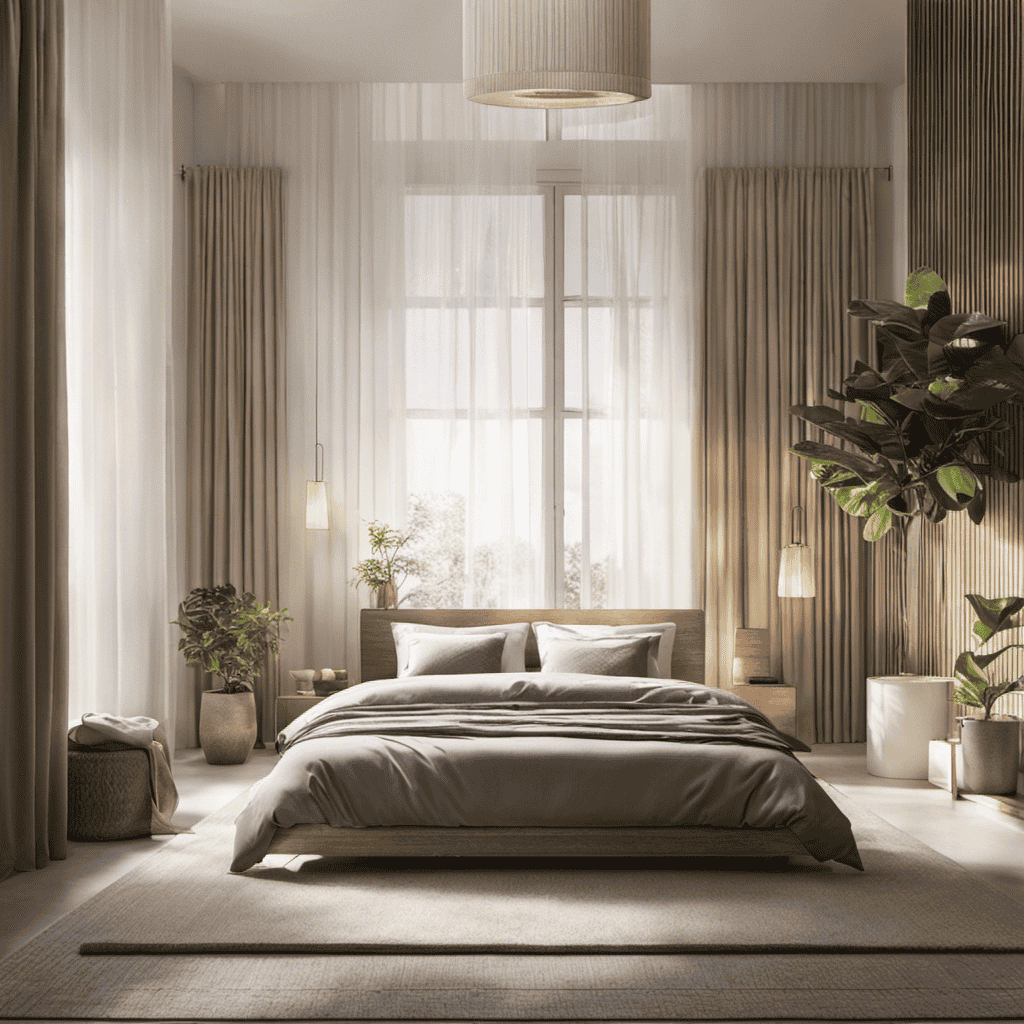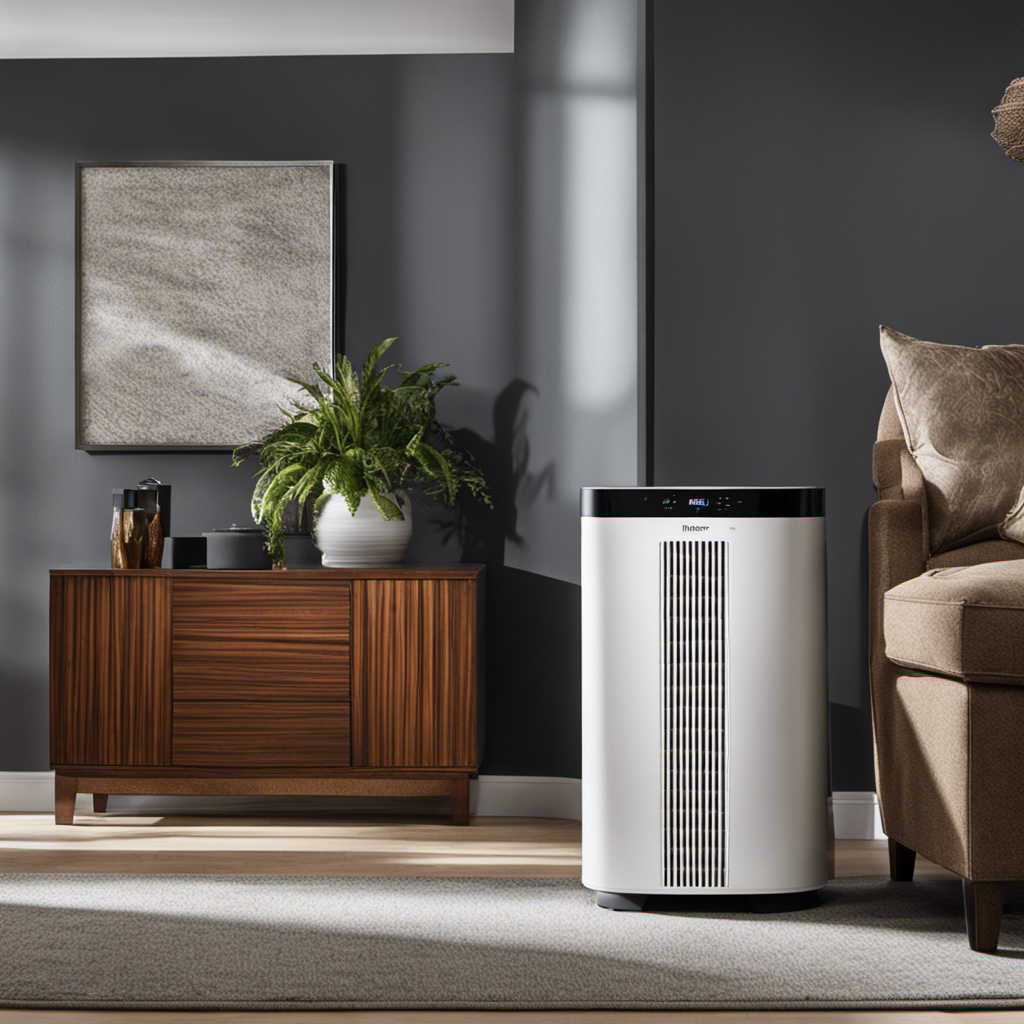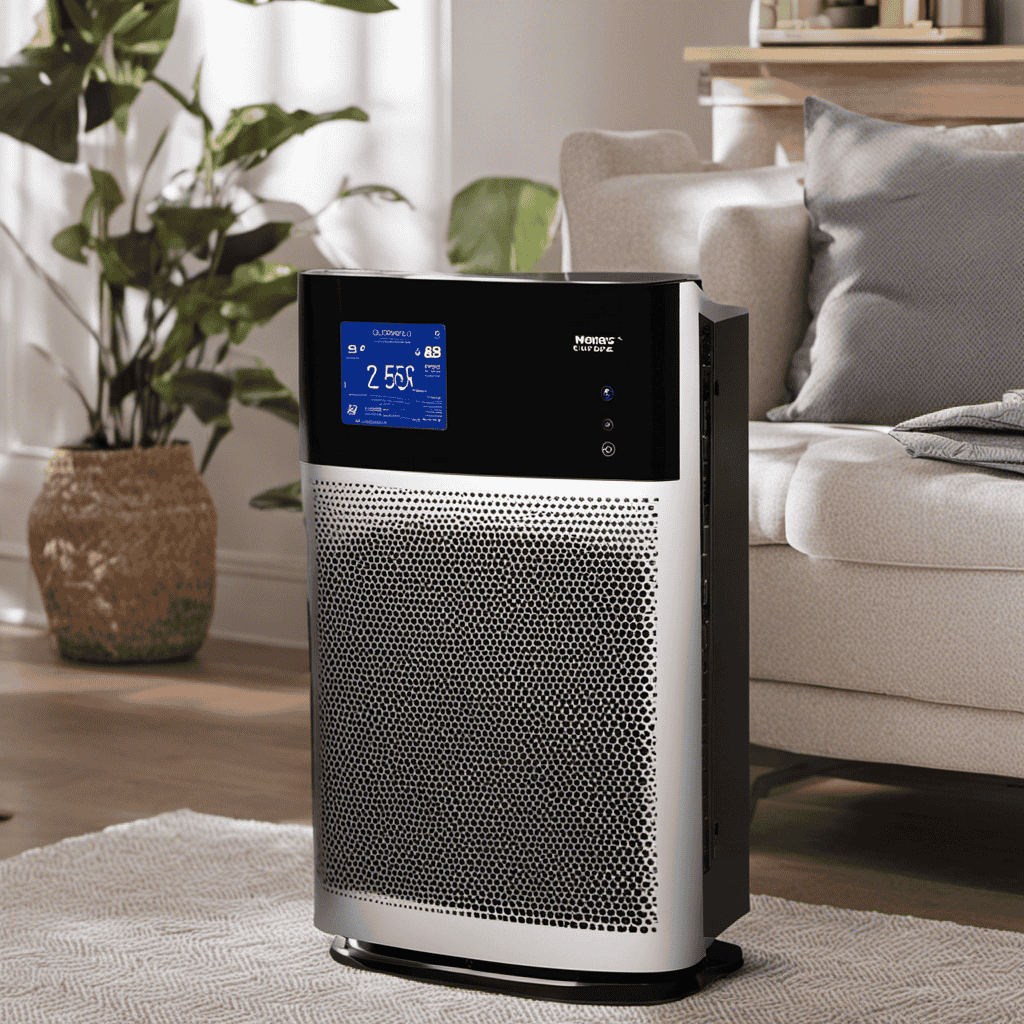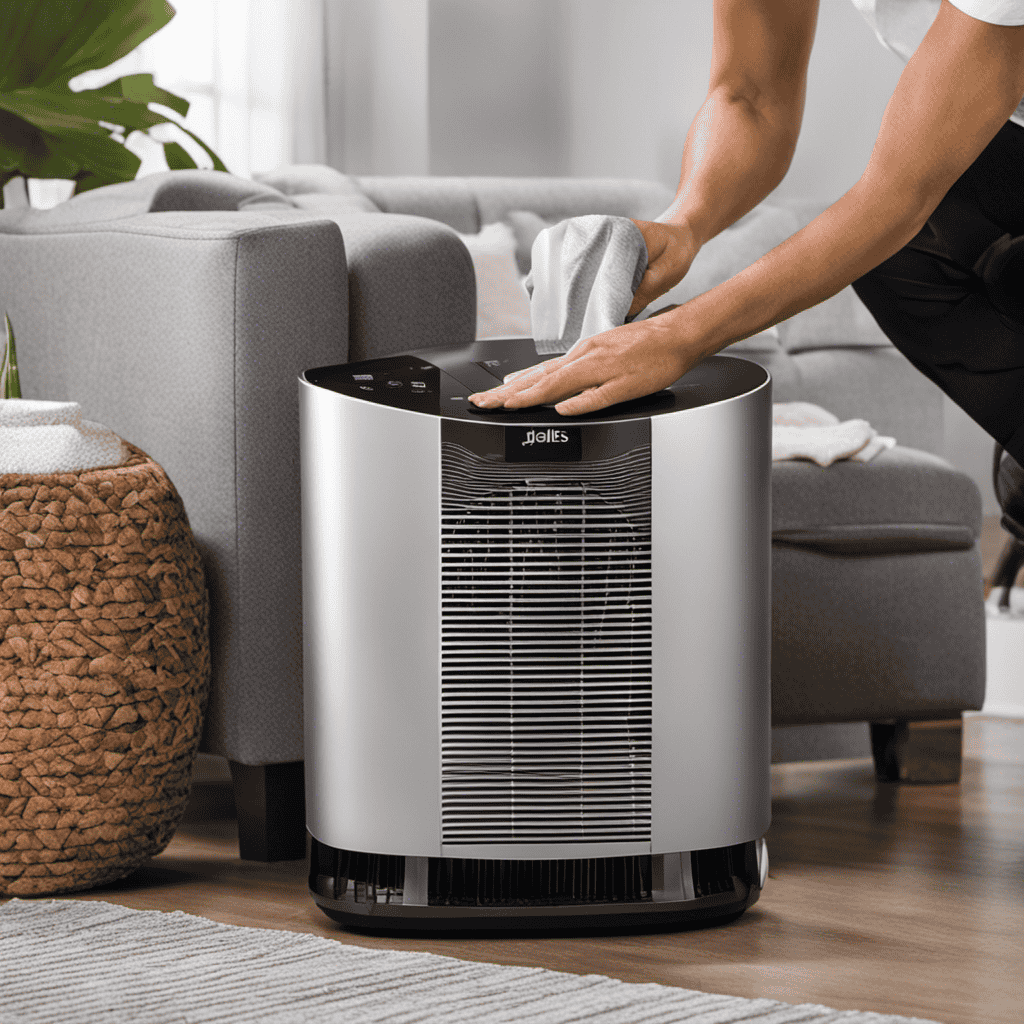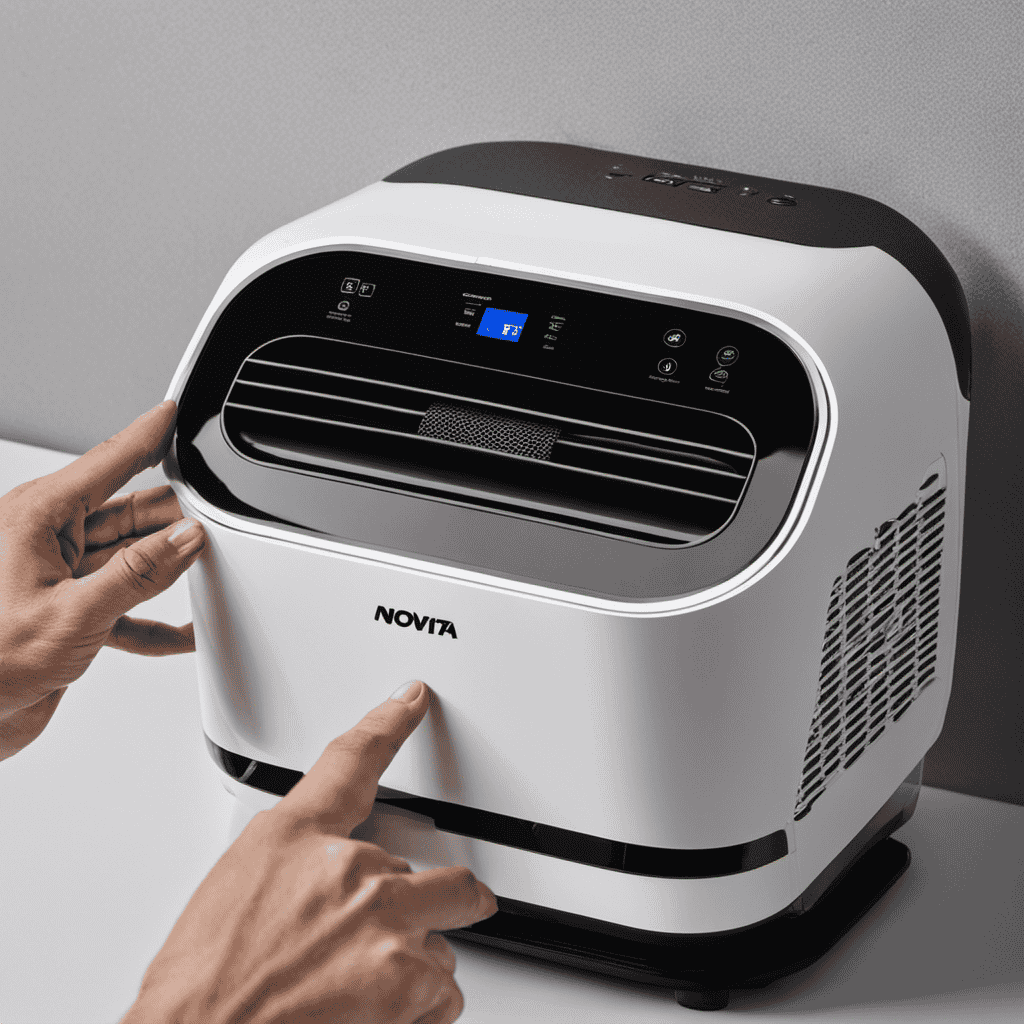I know what you’re thinking – air purifiers can be complicated and confusing to use. But fear not! In this article, I will guide you through the step-by-step process of using the Rainmate Air Purifier.
From unboxing and assembly to understanding the controls and adjusting the fan speed, I’ll cover all the essential details.
Plus, I’ll provide tips on choosing the right essential oil, using the purifier in different rooms, and even troubleshooting common issues.
So let’s dive in and discover how to make the most of your Rainmate Air Purifier!
Key Takeaways
- Handle the package with care to avoid damage
- Connect the power cord to the designated port
- Fill the water basin with clean water up to the marked level
- Adjust settings, including fan speed, timer function, and LED light control
Unboxing and Assembly
Now, it’s time to unbox your Rainmate air purifier and start assembling it. When unboxing your Rainmate, make sure to handle the package with care to avoid any damage.
Start by removing the packaging materials and taking out the main unit. Inside the box, you will also find the power cord and the water basin.
Connect the power cord to the designated port on the back of the unit.
Next, fill the water basin with clean water up to the marked level. Carefully place the basin back into the unit, ensuring it is securely in place.
Finally, plug in the power cord and turn on your Rainmate air purifier.
Follow these assembly guidelines to ensure proper setup of your Rainmate for optimal air purification performance.
Understanding the Controls
To adjust the settings on the Rainmate air purifier, simply press the power button and select your desired mode. The air purifier offers various modes to suit your needs, including a timer function and LED light control.
The timer settings allow you to choose how long you want the purifier to run before automatically shutting off. This is particularly useful if you only want it to run for a certain period of time, such as while you sleep or when you leave the house.
The LED light control allows you to adjust the brightness or turn off the lights completely, depending on your preference. With these features, you have full control over the operation and customization of your Rainmate air purifier.
Now, let’s move on to the next section and learn how to fill the water tank for optimal performance.
Filling the Water Tank
When filling the water tank, make sure to use clean, filtered water for best results. This will help prevent water spills and ensure the optimal functioning of your Rainmate air purifier.
To fill the tank, locate the fill line indicator on the side of the tank. Slowly pour the filtered water into the tank, being careful not to overfill it. Overfilling can lead to water spills and damage the unit.
Once the tank is filled, securely close the tank cap to prevent any leaks. It is important to follow these steps to maintain the efficiency and longevity of your Rainmate air purifier.
Adjusting the Fan Speed
To adjust the fan speed, simply turn the dial on the side of the unit to your desired setting. The Rainmate air purifier offers a variety of fan speed options to ensure optimal air purification for your space.
Here are three important things to know about fan speed adjustment:
-
Noise Level Control: As you increase the fan speed, the noise level of the unit may also increase. This is because the faster the fan spins, the more air it moves, resulting in a higher noise output. If you prefer a quieter operation, you can lower the fan speed to reduce the noise level.
-
Air Circulation: The fan speed directly affects the rate at which air is circulated in the room. Higher fan speeds can help to quickly filter and purify the air in larger spaces, while lower fan speeds are suitable for smaller rooms or areas where a more gentle air circulation is desired.
-
Energy Consumption: It’s important to note that higher fan speeds consume more energy. If energy efficiency is a concern, you can choose a lower fan speed to reduce power consumption while still enjoying the benefits of air purification.
Choosing the Right Essential Oil
For optimal results, consider selecting an essential oil that aligns with your desired benefits and preferences. When it comes to aromatherapy, different fragrances offer various benefits to support your well-being.
Lavender, for example, promotes relaxation and sleep, while eucalyptus can provide respiratory relief. To select the right fragrance, start by identifying the specific aromatherapy benefits you are seeking. Are you looking to reduce stress, improve focus, or enhance mood?
Once you have determined your desired benefits, research the corresponding essential oils known for those effects. Consider your personal preferences as well – some people prefer floral scents, while others enjoy more earthy or citrusy aromas.
Using the Rainmate Air Purifier in Different Rooms
When it comes to using the Rainmate Air Purifier in different rooms, there are a few key points to consider.
First, it’s important to determine the best room settings for optimal performance. This includes factors such as room size, air quality, and the specific needs of each room.
Additionally, proper maintenance is crucial to ensure the longevity and effectiveness of the purifier. Regular cleaning and filter replacements are essential to keep the device running smoothly and efficiently.
Best Room Settings
Adjust the Rainmate air purifier settings in your room to find the best combination of airflow and fragrance. Here are three key factors to consider:
-
Adjusting Humidity Levels: The Rainmate air purifier has a built-in humidifier function that can help maintain the ideal humidity level in your room. By adjusting the humidity settings, you can create a more comfortable environment and reduce the risk of dryness or excessive moisture. Experiment with different humidity levels to find the one that suits you best.
-
Using the Timer Feature: The Rainmate air purifier also has a timer feature that allows you to set specific operating hours. This is especially helpful if you want the purifier to run only during certain times of the day or night. Set the timer according to your preferences and schedule to ensure optimal performance and energy efficiency.
-
Finding the Right Fragrance Level: The Rainmate air purifier offers different fragrance options to enhance the air quality in your room. Experiment with different fragrance levels to find the one that suits your preferences without overwhelming the space. Remember, the goal is to create a pleasant and refreshing atmosphere, so adjust accordingly.
Maintenance Tips
Regularly cleaning and replacing filters is important to ensure optimal performance and prolong the lifespan of your Rainmate air purifier. The Rainmate air purifier uses advanced cleaning techniques to remove odors and improve the air quality in your home.
To effectively clean the unit, follow these steps:
- Turn off and unplug the purifier.
- Remove the water basin and empty any remaining water.
- Clean the water basin and the fan blade with a mild detergent and warm water. Rinse thoroughly and let them dry completely before reassembling.
- Remove the filter cover and replace the old filter with a new one. Make sure to align it properly.
- Wipe the exterior of the purifier with a damp cloth to remove any dust or dirt.
- Plug in the purifier and turn it on to enjoy fresh, clean air.
Regular maintenance and proper cleaning techniques will ensure your Rainmate air purifier continues to remove odors effectively and provide a healthy environment for you and your family.
Cleaning and Maintenance Tips
When it comes to maintaining the Rainmate Air Purifier, there are three key areas to focus on: cleaning frequency and methods, preventing mold and bacteria, and replacing filters and parts.
To ensure optimal performance, it is recommended to clean the Rainmate Air Purifier at least once a month, using a soft cloth and mild detergent.
Additionally, regular cleaning helps prevent the buildup of mold and bacteria, which can affect the air quality in your home.
Lastly, don’t forget to replace the filters and parts as recommended by the manufacturer to keep your Rainmate Air Purifier running efficiently.
Cleaning Frequency and Methods
To keep your Rainmate air purifier clean and functioning properly, you should make sure to clean it regularly using the recommended methods. Here is a cleaning schedule and the recommended cleaning products that you can use:
Cleaning Schedule:
- Clean the Rainmate air purifier at least once every two weeks.
- If you live in a dusty environment or have pets, consider cleaning it once a week.
- Deep clean the unit once a month by disassembling and cleaning each component.
Recommended Cleaning Products:
- Use distilled water or a mixture of water and vinegar to clean the water basin.
- Use a soft, damp cloth to wipe the exterior of the unit.
- Use a small brush or toothbrush to clean the fan blade and other hard-to-reach areas.
By following this cleaning schedule and using the recommended cleaning products, you can ensure that your Rainmate air purifier remains clean and functions effectively.
Now, let’s move on to the next section about preventing mold and bacteria.
Preventing Mold and Bacteria
To prevent mold and bacteria from growing in your air purifier, it’s important to keep the water basin clean and dry at all times. This is crucial for maintaining a healthy and allergen-free environment.
Mold and bacteria thrive in moist and damp conditions, so by ensuring that the water basin is dry, you can effectively prevent their growth. Regularly cleaning the water basin with mild detergent and warm water is also recommended to remove any dirt or residue that may accumulate.
Additionally, consider using distilled or purified water to minimize the introduction of impurities. By implementing these preventive measures, you can enjoy the benefits of air purification without worrying about potential health hazards.
Now let’s move on to the next section on replacing filters and parts.
Replacing Filters and Parts
Make sure you regularly replace the filters and parts in your air purifier to ensure optimal performance and clean air quality. Here are three important things to keep in mind when replacing filters and parts:
-
Follow the manufacturer’s instructions: Different air purifiers have different filter replacement schedules and requirements. It is essential to refer to the user manual or manufacturer’s guidelines to determine when and how to replace filters and parts.
-
Use genuine replacement filters and parts: To maintain the effectiveness of your air purifier, it is crucial to use genuine replacement filters and parts that are specifically designed for your model. Generic or incompatible filters may not fit properly or may not effectively remove pollutants from the air.
-
Regularly clean and maintain your air purifier: In addition to replacing filters, it is important to regularly clean and maintain your air purifier. This includes cleaning the exterior, checking for any blockages or obstructions, and ensuring proper airflow.
By following these tips for replacing filters and parts, you can ensure that your air purifier continues to function at its best, providing you with clean and fresh air.
Now, let’s move on to troubleshooting common issues with your air purifier.
Troubleshooting Common Issues
If the Rainmate air purifier is not turning on, check if it’s properly plugged in. Sometimes the simplest solution is the most overlooked one. Ensure that the power cord is securely connected to both the purifier and the electrical outlet. If the purifier still doesn’t turn on, there may be an issue with the power supply. Try plugging the purifier into a different outlet to rule out any problems with the original outlet. If the purifier is still not working, it’s time to troubleshoot further. One common issue is noise problems. This can be caused by a loose fan or a dirty motor. Cleaning the motor and tightening any loose parts can often resolve this issue. Another common problem is power problems. If the purifier is not receiving enough power, it may not function properly. In such cases, using a voltage regulator or a surge protector can help stabilize the power supply and resolve the issue.
| Possible Issues | Solutions |
|---|---|
| Not turning on | Check the power cord and outlet connectivity |
| Noise issues | Clean the motor, tighten loose parts |
| Power problems | Use a voltage regulator or surge protector |
Frequently Asked Questions
Can the Rainmate Air Purifier Remove Pet Dander and Allergens From the Air?
Yes, the Rainmate air purifier effectively removes pet dander and allergens from the air. It is a great option for improving indoor air quality. However, there are alternative air purifiers that can also achieve similar results.
How Long Does the Water in the Tank Last Before It Needs to Be Refilled?
The water in the tank of the Rainmate air purifier typically lasts for several days before needing to be refilled. It’s important to clean the purifier regularly to maintain its effectiveness and enjoy the benefits of cleaner air.
Can I Use Tap Water in the Rainmate Air Purifier?
Yes, you can use tap water in the Rainmate Air Purifier. However, it is important to note that using alternative water sources, such as distilled or filtered water, may help ensure the safety and longevity of the device.
Is It Safe to Leave the Rainmate Air Purifier Running Overnight?
Yes, it is safe to leave the Rainmate air purifier running overnight. It is not noisy and has a warranty. However, it is important to follow the manufacturer’s instructions for optimal usage.
Can I Use the Rainmate Air Purifier in a Large Open Space or Only in Smaller Rooms?
I can use the Rainmate air purifier in a large open space or smaller rooms. It is suitable for commercial spaces and outdoor use. The purifier effectively cleans the air, making it safe to breathe.
Conclusion
In conclusion, the Rainmate air purifier is an excellent addition to any home or office space. Its easy assembly and user-friendly controls make it a breeze to use. By filling the water tank and adjusting the fan speed, you can customize the purification process to meet your specific needs.
Additionally, choosing the right essential oil can enhance the overall experience, creating a soothing and refreshing atmosphere. For example, in a case study conducted in a small bedroom, the Rainmate air purifier effectively eliminated musty odors and improved air quality within a few hours of use.
With regular cleaning and maintenance, the Rainmate air purifier will continue to provide fresh and clean air for years to come.
